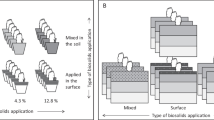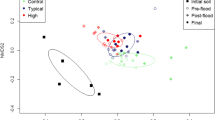Abstract
The impact of biosolids on soil processes in five soils under pasture was assessed. Five biosolid treatments (control, dried pellets, compost, biosolids at 200 kg N/ha, and biosolids at 800 kg N/ha) were mixed in 0- to 10-cm-deep soil in lysimeters each year. Nematodes were sampled after 2 years. Many of the nematode populations and indices showed significant soil effects. Nematode responses to the range of biosolid amendments were similar across the five soils. Few populations showed an interaction between the type of amendment and the soil. The most marked response to amendment was that of bacterial-feeding Rhabditidae, in which populations were affected by the weight of the biosolid amendment. Nematode contribution to the soil processes in these soils was not adversely affected by the application of biosolids.
Similar content being viewed by others
References
Cameron KC, Di HJ, McLaren RG (1997) Is soil an appropriate dumping ground for our wastes? Aust J Soil Res 35:995–1035
Cameron KC, Smith NP, McLay CDA, Fraser PM, McPherson RJ, Harrison DF, Harbottle P (1992) Lysimeters without edge-flow: an improved design and sampling procedure. Soil Sci Soc Am J 56:1625–1628
Entry JA, Wood BH, Edwards JH, Wood CH (1997) Influence of organic by-products and nitrogen source on chemical and microbiological status of an agricultural soil. Biol Fertil Soils 24:196–204
Epstein E (2002) Land application of sewage sludge and biosolids. CRC, Boca Raton
Griffiths BS, Neilson R, Bengough AG (2003) Soil factors determined nematode community composition in a two year pot experiment. Nematology 5:889–897
Guisquiani PL, Gigliotti G, Businelli D (1994) Long-term effects of heavy metals from composted municipal waste on some enzyme activities in a cultivated soil. Biol Fert Soils 17:257–262
Hewitt AE (1998) New Zealand soil classification. Landcare Research Science Series no 1. Manaaki Whenua, Lincoln
Hohberg K (2003) Soil nematode fauna of afforested mine sites: genera distribution, trophic structure and functional guilds. Appl Soil Ecol 22:113–126
Lilburne LR, Hewitt AE, Sparling GP, Selvarajah N (2002) Soil quality in New Zealand—policy and the science response. J Environ Qual 31:1768–1773
Mulder CH, De Zwart D, van Wijnen HJ, Schouten AJ, Breure AM (2003) Observational and simulated evidence of ecological shifts within the soil nematode community of agroecosystems under conventional and organic farming. Funct Ecol 17:516–525
O’Connor GA, Elliott HA, Basta NT, Bastina RK, Pierzynski GM, Sims RC, Smith JE (2005) Sustainable land application. J Environ Qual 34:7–17
Parham JA, Deng SP, Raun WR, Johnson GV (2002) Long-term cattle manure application on soil. I. Effect on soil phosphorus levels, microbial biomass C, and dehydrogenase and phosphatase activities. Biol Fertil Soils 35:328–337
Speir TW, van Schaik AP, Lloyd-Jones AR, Kettles HA (2003) Temporal response of soil biochemical properties in a pastoral soil after cultivation following high application rates of undigested sewage sludge. Biol Fertil Soils 38:377–385
Speir TW, Horswell J, van Schaik AP, McLaren RG, Fietje G (2004) Composted biosolids enhance fertility of a sandy loam soil under dairy pasture. Biol Fertil Soils 40:349–358
Wardle DA, Yeates GW, Watson RN, Nicholson KS (1995) Development of the decomposer food-web, trophic relationships, and ecosystem properties during a three-year primary succession of sawdust. Oikos 73:155–166
Wardle DA, Williamson WM, Yeates GW, Bonner KI (2005) Trickle-down effects of aboveground trophic cascades on the soil food web. Oikos 111:348–358
Yeates GW (1978) Populations of nematode genera in soils under pasture. I. Seasonal dynamics in dryland and irrigated pasture on a southern yellow-grey earth. NZ J Agric Res 21:321–330
Yeates GW (1984) Variation in soil nematode diversity under pasture with soil and year. Soil Biol Biochem 16:95–102
Yeates GW (2003) Nematodes as soil indicators: functional and biodiversity aspects. Biol Fertil Soils 37:199–210
Yeates GW, Bongers T (1999) Nematode diversity in agroecosystems. Agric Ecosyst Environ 74:113–135
Yeates GW, Pattison AB (2005) Moving up the Food Chain: Protozoa and nematodes. In: Uphoff N, Ball AS, Fernandes ECM, Herren HR, Husson O, Laing M, Palm C, Pretty JN, Sanchez PA, Sanginga N, Thies JE (eds) Biological approaches to sustainable soil systems. CRC Press, Boca Raton, pp 149–162
Yeates GW, Bardgett RD, Cook R, Hobbs PJ, Bowling PJ, Potter JF (1997) Faunal and microbial diversity in three Welsh grassland soils under conventional and organic management regimes. J Appl Ecol 34:453–470
Yeates GW, Bongers T, de Goede RGM, Freckman DW, Georgieva SS (1993a) Feeding habits in soil nematode families and genera—an outline for soil ecologists. J Nematol 25:315–331
Yeates GW, Wardle DA, Watson RN (1993b) Relationships between nematodes, soil microbial biomass and weed management strategies in maize and asparagus cropping systems. Soil Biol Biochem 25:869–876
Yeates GW, Ross CW, Dando JL, Speir TW (2002) Some effects of incorporation of compost including sewage biosolids into a dairy pasture on Foxton sandy loam. NZ Soil News 50:5–8
Zebarth NJ, Neilsen GH, Hogue E, Neilsen D (1999) Influence of organic waste amendments on selected soil physical and chemical properties. Can J Soil Sci 79:501–504
Acknowledgements
This work was funded by the New Zealand Foundation for Research, Science and Technology. Chris Mercer and a referee made constructive comments on the manuscript.
Author information
Authors and Affiliations
Corresponding author
Appendix
Appendix
The 45 nematode taxa discriminated and the probability of the effects of soil, treatment, and their interaction on nematode abundance. Based on unbalanced ANOVA of loge (n+1) transformed counts per core from all 63 lysimeters. Probabilities <0.05 are in bold
Taxon | Effects from unbalanced ANOVA | ||
|---|---|---|---|
| Soil | Treatment | Soil × Treatment |
Tylenchus | <0.001 | 0.013 | 0.336 |
Boleodorus | 0.031 | 0.835 | 0.914 |
Cephalenchus | <0.001 | 0.387 | 0.155 |
Ditylenchus | 0.059 | 0.579 | 0.638 |
Heterodera juv. | <0.001 | 0.014 | 0.013 |
Meloidogyne juv. | 0.664 | 0.051 | 0.440 |
Hoplolaimidae | <0.001 | 0.763 | 0.591 |
Pratylenchus | 0.219 | 0.119 | 0.839 |
Paratylenchus | 0.272 | 0.323 | 0.480 |
Aphelenchus | 0.184 | 0.359 | 0.593 |
Aphelenchoides | 0.008 | 0.111 | 0.100 |
Diplogaster | 0.532 | 0.454 | 0.394 |
Panagrolaimus | 0.012 | 0.116 | 0.263 |
Rhabditidae | 0.360 | <0.001 | 0.531 |
Cephalobus | 0.097 | 0.375 | 0.528 |
Heterocephalobus | <0.001 | 0.027 | 0.602 |
Acrobeles | <0.001 | 0.700 | 0.453 |
Cervidellus | 0.517 | 0.628 | 0.589 |
Teratocephalus | 0.532 | 0.251 | 0.524 |
Plectus | 0.016 | 0.329 | 0.784 |
Anaplectus | 0.016 | 0.167 | 0.027 |
Prismatolaimus | <0.001 | 0.254 | 0.220 |
Wilsonema | 0.532 | 0.454 | 0.394 |
Monhystera | 0.038 | 0.528 | 0.968 |
Geomonhystera | 0.278 | 0.555 | 0.134 |
Chromadoridae | |||
(microbial feeding) | 0.002 | 0.508 | 0.796 |
Rhabdolaimus | 0.405 | 0.773 | 0.388 |
Enoplidae | 0.093 | 0.769 | 0.808 |
Dorylaimus | 0.053 | 0.007 | 0.579 |
Mesodorylaimus | 0.382 | 0.361 | 0.729 |
Eudorylaimus 1 | 0.266 | 0.843 | 0.625 |
Eudorylaimus 2 | 0.020 | 0.885 | 0.836 |
Labronema | 0.010 | 0.644 | 0.019 |
Pungentus | <0.001 | 0.088 | 0.171 |
Aporcelaimus | <0.001 | 0.351 | 0.858 |
Longidorus | <0.001 | <0.001 | <0.001 |
Sectonema | 0.065 | 0.543 | 0.159 |
Dorylaimellus | 0.277 | 0.173 | 0.755 |
Tylencholaimus | 0.306 | 0.540 | 0.524 |
Doryllium | 0.004 | 0.239 | 0.254 |
Mononchidae 1 | <0.001 | 0.099 | 0.006 |
Mononchidae 2 | 0.532 | 0.251 | 0.524 |
Alaimidae | 0.080 | 0.729 | 0.981 |
Trichodoridae | <0.001 | 0.969 | 0.999 |
Diphtherophora | 0.014 | 0.608 | 0.765 |
Rights and permissions
About this article
Cite this article
Yeates, G.W., Speir, T.W., Taylor, M.D. et al. Nematode responses to biosolids incorporation in five soil types. Biol Fertil Soils 42, 550–555 (2006). https://doi.org/10.1007/s00374-005-0050-9
Received:
Revised:
Accepted:
Published:
Issue Date:
DOI: https://doi.org/10.1007/s00374-005-0050-9




